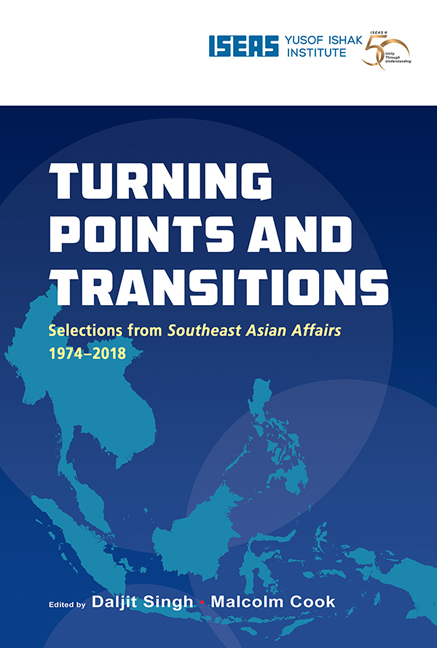Book contents
- Frontmatter
- Contents
- Message from the Director
- Foreword
- Foreword
- Introduction
- THE REGION
- BRUNEI
- CAMBODIA
- INDONESIA
- LAOS
- MALAYSIA
- MYANMAR
- THE PHILIPPINES
- SINGAPORE
- Singapore's Foreign Policy in the Seventies: The Reconciliation of Global and Regional Interests (1974)
- The Downturn in the Singapore Economy: Problems, Prospects and Possibilities for Recovery (1986)
- A Return to Normal Politics: Singapore General Elections 2011 (2012)
- THAILAND
- VIETNAM
Singapore's Foreign Policy in the Seventies: The Reconciliation of Global and Regional Interests (1974)
from SINGAPORE
Published online by Cambridge University Press: 29 May 2019
- Frontmatter
- Contents
- Message from the Director
- Foreword
- Foreword
- Introduction
- THE REGION
- BRUNEI
- CAMBODIA
- INDONESIA
- LAOS
- MALAYSIA
- MYANMAR
- THE PHILIPPINES
- SINGAPORE
- Singapore's Foreign Policy in the Seventies: The Reconciliation of Global and Regional Interests (1974)
- The Downturn in the Singapore Economy: Problems, Prospects and Possibilities for Recovery (1986)
- A Return to Normal Politics: Singapore General Elections 2011 (2012)
- THAILAND
- VIETNAM
Summary
Although it is false to assume that a new decade ushers in a new era, in the study of international politics it is in many ways convenient to think in terms of decades, because it allows for a point in time to assess the past, to analyse the present and to point to the future. With this proviso made, it can nevertheless be asserted that the first three years of the 1970's have marked a watershed in the international affairs of Asia and particularly Southeast Asia. The events which have changed the pattern of international relations in Southeast Asia and will clearly distinguish the present decade from the past include:
First, the rapprochement between China and the West and the rest of Asia, heralded by President Nixon's visit to Peking in February 1972 and the seating of China in the United Nations in 1971.
Second, the reshaping of American policy in the region along the lines of the Nixon Doctrine of self-help and put into effect through the winding down of the Vietnam War, the signing of the Vietnam Ceasefire Agreement in January 1973, and the phased withdrawal of American troops from Vietnam and Southeast Asia.
Third, the withdrawal of British military bases from Malaysia and Singapore initiated in 1968 and completed in 1971 and succeeded by the more fluid and ambiguous Five Power Defence Arrangements between Australia, New Zealand and the United Kingdom (ANZUK) and Malaysia and Singapore.
Fourth, the increasing Sino-Soviet rivalry, and the growing Soviet involvement in South and Southeast Asia marked by the Soviet-Indian Treaty of 1971 and the expanding Russian naval presence in the Pacific and Indian Oceans.
Fifth, the growing Japanese domination of the economies and markets of Southeast Asia, and the shaping of a new political role for Japan in Asian affairs commensurate with her economic power.
Finally, the shifting of the foreign policies of Australia and New Zealand to a more Asian orientation and to a greater involvement in Asian affairs following the Labour Party victories in both countries.
Despite a reduction in tension, however, Southeast Asia still remains in a state of flux and transition.
- Type
- Chapter
- Information
- Turning Points and TransitionsSelections from Southeast Asian Affairs 1974-2018, pp. 585 - 600Publisher: ISEAS–Yusof Ishak InstitutePrint publication year: 2018



